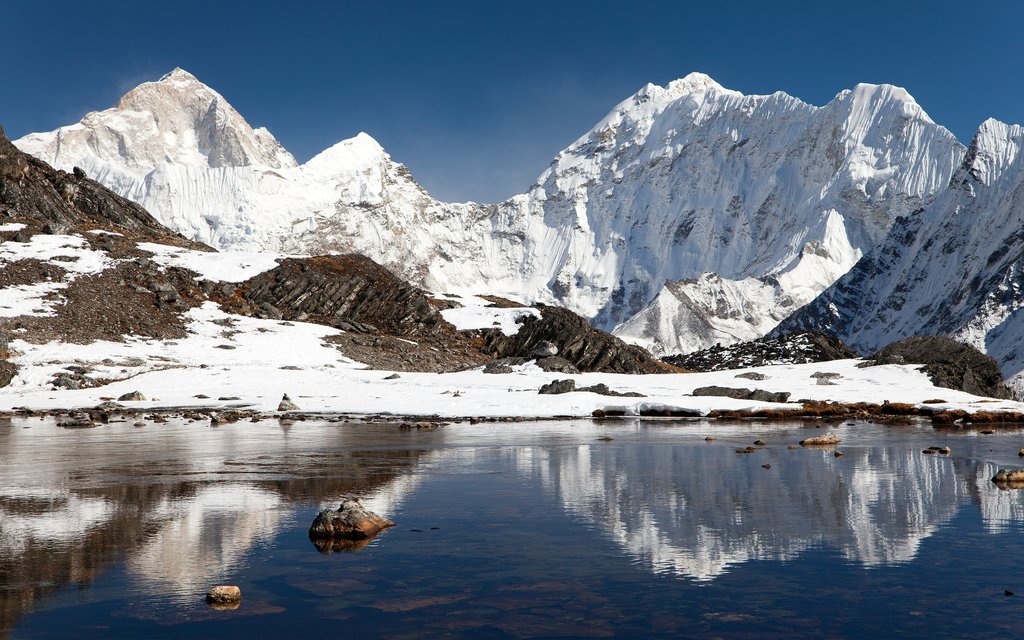Why Camp for a Night?
Most treks in Nepal are either teahouse or camping treks. Teahouses offer comfort, and camping allows access to remote places where traveler infrastructure hasn’t yet developed. Light camping treks offer the best aspects of both: in the Everest region there are plenty of teahouses along the way, and remote areas (shared by fewer trekkers) open up to you if you can spend a night or two camping. Combined, trekkers can enjoy comfort and adventure.
Ama Dablam Base Camp

On the return trek from Everest Base Camp, add a night of camping at Ama Dablam Base Camp from either Pheriche or Dingboche villages. Ama Dablam's peak can be seen from few vantage points in the Everest region, including the prime camp spots you can snag at the foot of the mountain. Set up and spend the afternoon exploring ridges and barely-trodden trails to find the perfect view. The next day, trek to Phortse, stopping at Pangboche for lunch and then visit the village's famous monastery, rejoining the teahouse route that night.
Combine this camp with:
Ama Dablam Base Camp Trek (12 days)
Everest Base Camp Trek (16 Days)
Chat with a local specialist who can help organize your trip.
Cho Oyu Base Camp

The Gokyo Lakes tre˚k is a popular alternative to the Everest Base Camp trek, and you can make it more unique by camping for a night further up the valley, past the chain of Gokyo lakes, at Cho Oyu base camp. This trail sees very few trekkers and you'll likely have unobstructed views of Everest from Scoundrel’s Point to yourself. The scenery at Cho Oyu Base Camp is beautiful and rugged, where you can spend the next morning explore various viewpoints before returning back to Gokyo village.
Combine this camp with:
Three Passes Trek (22 days)
Gokyo Lakes Trek (16 days)
Pokalde Base Camp

This remote campsite lies high up in the ridgeline that divides the Everest and Chukhung Valleys. From the Chukhung side, you'll first trek to Pokalde Base Camp, where you may want to camp during colder months. From here, the trail gets steeper before reaching the second base camp, located next to a clear blue lake at the foot of Kongma La. It’s a spectacular setting and no doubt one of your most memorable nights in Nepal. The next day, rise early and climb Mount Pokalde (19,000 ft / 5794 m). Without snow, it is more of a scramble than a climb, and the summit is a perfect spot for a morning picnic with commanding views of the Khumbu region.
Combine this camp with:
Three Passes Trek (22 days)
How Overnight Camps Work
As with other treks in Nepal, you'll be accompanied by a guide and porter who will set up camp. The porter will carry tents and cooking equipment, but because less is required than on a full camping trek, you will need less help and costs will be kept to a minimum.
Depending on the season, temperatures could be cold. Bring a sleeping bag that’s suitable for the season. Tents and insulated sleeping pads are normally supplied by your trekking company. Bring warm clothes for high altitude, whatever the season—down is best as it’s lightweight and warm.
You may be surprised how tasty food that comes out of a packet can be (and after a day of trekking, almost anything tastes delicious anyway). Contemporary camping foods offer a wide variety of easy-to-prepare dishes, from pasta carbonara to chocolate mousse.
